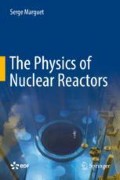Abstract
Fuel undergoes significant nuclear transformations during its life in the reactor. Fission reactions modify isotopic concentrations and considerably affect neutron flux calculations. Heavy isotopes undergo fission and produce absorbing fission products that modify the neutron spectrum. Furthermore, fissile plutonium isotopes are also formed by capture reactions for uranium 238 and thus partially regenerate the fuel. The variations in the concentration of xenon 135—a powerful absorbing isotope produced by fission—lead to transient reactivity perturbations that can hinder the smooth running of the reactor for the operator: this is the so-called “iodine pit”. Enrico Fermi experimentally discovered the “xenon effect” which may prevent the reactor from starting, although for a short period only. In the higher power Hanford reactor (USA), initially conceived to produce plutonium for the atomic bomb, Eugen Wigner allowed for voided channels as he anticipated the need to insert supplementary uranium pins to counter the xenon effect.
Access this chapter
Tax calculation will be finalised at checkout
Purchases are for personal use only
Notes
- 1.
H. Bateman, Proc. Cambridge Phil. Soc. 15, 423 (1910). Harry Bateman (1882–1946) was a British mathematician who studied at Cambridge, Gottingen and Paris. He left for the United States in 1910 and defended his PhD thesis in 1913 at the prestigious John Hopkins University. He became a professor at Caltech in 1917. He made several contributions to numerical analysis for physics in various fields such as electromagnetism, fluid mechanics and geophysics. In 1936, he became the vice-president of the American Mathematical Society. His favorite pastime was writing pages on the properties of transcendental functions. After his death, at the end of the 1940s, a team of well-known mathematicians, numbering Arthur Erdeli and F. Oberhettinger, worked on this huge collection: the Bateman Manuscripts were published as five famous books: Higher Transcendental Functions Volumes 1, 2, 3, and Tables of Integral Transforms 1 and 2, which are of great interest to a reactor physicist, especially volume 1 (Erdélyi 1954), which contains tables of Fourier and Laplace transforms.
- 2.
This is the value assigned in EDF codes.
- 3.
Frédéric Laugier (1973–) began his career at EDF/R&D in 2001 after his studies at the Ecole Centrale de Paris. He is a world-recognized specialist in decay heat, and he has contributed to improvement of the international norms in this field. For instance, in 2007, he proposed a didactic representation of decay heat using Laugier curves having a precision/complexity ratio sufficient to enable rapid calculation of this parameter.
 (Courtesy Laugier)
(Courtesy Laugier) - 4.
François Storrer: Contribution à l’élaboration et la qualification de la bibliothèque DARLING des données nucléaires de base du formulaire multifilière DARWIN de la physique du cycle du combustible [Contribution to the conception and validation of the DARLING library of basic nuclear data for the DARWIN scheme for fuel cycle physics], PhD thesis, University of Orsay (1993).
- 5.
J.K. Dickens, T.A. Love and al, Nucl.Sci. Eng., 106 (1980).
- 6.
M. Akiyama, S. An, Jap. At. En. Soc., 709 (1982).
- 7.
This is the method used in the STRAPONTIN code (S. Marguet , O. Dekens , F. Laugier et. al.), which is the official decay heat calculation code for PWR at EDF.
- 8.
Richard Babut : Modélisation des réactions (α, n) sur les noyaux légers pour déterminer la source inhérente d’un réacteur nucléaire [Modeling of (α, n) reactions on light nuclides to determine the inherent source of a nuclear reactor], PhD from Blaise Pascal University (2002).
- 9.
From JEF 2.2. It is the most absorbing fission product in thermal spectrum (but not in fast spectrum where it is superseded by samarium 151).
- 10.
Gilles Mathonnière : Etudes de problèmes neutroniques liés à la présence de xénon dans les réacteurs à eau pressurisée [Neutron studies on the presence of xenon in pressurized water reactors], PhD thesis at the University of Orsay (1988).
- 11.
from JEF 2.2
- 12.
David Couyras : personal communication
- 13.
Patrick Chaucheprat : Qualification du calcul des poisons consommables au gadolinium dans les réacteurs à eau [Experimental validation of the calculation of burnable poisons in water reactors], PhD thesis, University of Orsay (1988).
- 14.
Mohamed Nasr : Etude des poisons consommables et qualification du gadolinium dans les réacteurs à eau [Study of burnable poisons and experimental validation of gadolinium in water reactors], PhD thesis, University of Orsay (1979).
- 15.
Pavel Klenov : Validation expérimentale des schémas de calcul relatifs aux absorbants et poisons consommables dans les REP [Experimental validation of calculation schemes for consumable poisons and absorbants in PWRs], PhD thesis, Université d’Aix-Marseille (1995).
- 16.
Paul Reuss states that in practice, mixtures occur, making it difficult to obtain enrichment above 3 or 4% in a single cycle.
Bibliography
Alain Baur, Protection contre les rayonnements : aspects physiques et méthodes de calcul [Radiation shielding: physical aspects and calculation methods], CEA/INSTN, ISBN 2-7272-0102-8, 1985, 287 pages. This is an excellent book on radiation physics and one of the most complete references for theoretical aspects [Métivier, 2006].
Michel Bertin, Les effets biologiques des rayonnements ionisants [The biological effects of ionizing radiation], Electricité de France, Paris, ISBN 2-901281-00-1, 1991, 382 pages. Written by a doctor. This book describes medical aspects of radiation on the body.
Joseph Bessis, Manuel de physique nucléaire [Nuclear physics textbook], Eyrolles, Paris, 1978. 166 pages. Few proofs from this book resulting from a lecture at INSTN, with all the required knowledge on reactor physics.
A. Erdélyi (Editor), Tables of integral transforms, volume 1, McGraw-Hill, New-York, USA, Library of Congress Card Number 54-6214, 1954, 391 pages. Based on the famous shoebox of Harry Bateman, this book deals with the unusual Fourier and Laplace transforms.
Denis-Jean Gambini, Robert Granier, Manuel pratique de radioprotection [Practical manual for radiation shielding], Tec&Doc, Lavoisier, ISBN 2-7430-0161-5, 1997, 2nd edition, 483 pages. Little theoretical considerations in this book aiming more at regulatory and practical aspects. The title is well suited for the book.
Bertrand Goldschmidt, Pionniers de l’atome [Atomic pioneers], Stock, Paris, 1987, 484 pages. Goldschmidt has been the only French who worked for the Manhattan Project on plutonium separation. He would become a very brilliant chemist at CEA and would propose the French solution. The photographs are somewhat deceiving (usual photographs, only those of the French coming to Canada are really interesting).
Gerald J. Hine, Gordon L. Brownell (Editors), Radiation dosimetry, Academic Press, New-York, USA, Library of Congress Card Number 56-6605, 1956, 932 pages, the first three chapters are theoretical considerations.
Georges Jurain, L’uranium [Uranium], Que sais-je collection, PUF, Paris, 1986, 126 pages. More directed towards geology. The ore refining to obtain the metal is well described.
Nordine Kerkar, Philippe Paulin, Exploitation des cœurs REP [Operating PWR cores], EDP Sciences-INSTN, Paris, ISBN 978-2-86883-3, 2008, 304 pages. It is a specialized work which presents the essential knowledge to operate PWR. The glossary is complete and gives an overview of the jargon with trigrams (thrre-letter abbreviations) which are often unfriendly to beginners.
John S. Lilley, Nuclear physics, John Wiley, Chichester, England, ISBN 0-471-97936-8, 2001, 393 pages. Lectures of the University of Manchester. Very complete. A chapter is devoted to fission reactors.
Robert M. Mayo, Introduction to nuclear concepts for engineers, American Nuclear Society, La Grange Park, Illinois, USA, ISBN 0-89448-454-0, 1998, 361 pages. This book is more than just a good introduction.
Raymond L. Murray, An Introduction to nuclear engineering, Prentice Hall, New-York, USA, Library of Congress Card Number 54-8207, 1954, 418 pages. More technological than physical.
Paul Reuss, Précis de neutronique [Neutron physics], EDP Sciences, collection INSTN, Paris, ISBN 2-86883-637-2, 2003, essential elements from [Bussac and Reuss 1985], with a more modern typography but simplified content (directed towards students in a more didactic form). The only textbook of pure neutron physics still available in French.
Theodore Rockwell III, Reactor shielding design manual, Van Nostrand, Princeton. USA, 1956, 472 pages. Chapter 1 deals with neutron attenuation and radiations.
Daniel Rozon, Introduction à la cinétique des réacteurs [Introduction to reactor kinetics], Editions de l’école polytechnique de Montréal, Canada, ISBN 2-253-00223-8, 1992, 413 pages, the most complete reference on kinetics in French. Essential for the accidentology of reactors. Rozon presents thoroughly the problem of the form function that is used in the point-kinetics model, which is not very much discussed in other references. However, the precision in the terms increases the names of variables (all the amplitudes must be described), thereby making it difficult to read: it is not obvious to recall that ζ(t) is the amplitude of the concentration of delayed neutrons. Besides, there is no index.
J. Kenneth Shultis, Richard E. Faw, Radiation shielding, American Nuclear Society, Illinois, USA, 2000, 462 pages. One of the most complete reference on the subject. Remarkable.
Weston M. Stacey, Nuclear reactor physics, John Wiley, USA, ISBN 0-471-39127-1, 2001, 707 pages.
Rudi J.J. Stamm’ler, Maximo J. Abbate, Methods of steady state reactor physics in nuclear design, Academic Press, USA, ISBN 0-12-663320-7, 1983, 506 pages. This book is very interesting although, chapter 2 is quite surprising with programming recommendations in Fortran which is not very appropriate considering the general framework of the book (?).
Richard S. Varga, Matrix iterative analysis, Prentice Hall, New-York, USA, Library of Congress card number n°62-21277, 1962, 222 pages. Two chapters on parabolic equations (stationary diffusion) and elliptic equations (time-dependent diffusion) are well adapted to understand diffusion theory in reactor physics. Clear and complete without “ultra-mathematical” aspects as is the case of some applied mathematics references.
Author information
Authors and Affiliations
Rights and permissions
Copyright information
© 2017 Springer International Publishing AG
About this chapter
Cite this chapter
Marguet, S. (2017). Fuel Cycle Physics. In: The Physics of Nuclear Reactors. Springer, Cham. https://doi.org/10.1007/978-3-319-59560-3_15
Download citation
DOI: https://doi.org/10.1007/978-3-319-59560-3_15
Published:
Publisher Name: Springer, Cham
Print ISBN: 978-3-319-59559-7
Online ISBN: 978-3-319-59560-3
eBook Packages: Physics and AstronomyPhysics and Astronomy (R0)


 (Courtesy Laugier)
(Courtesy Laugier)